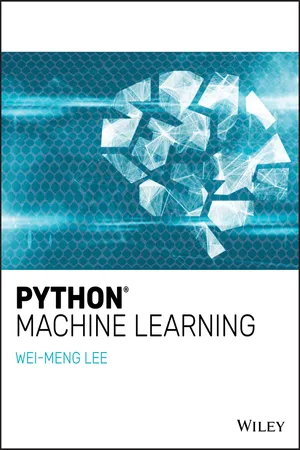
- English
- ePUB (mobile friendly)
- Available on iOS & Android
Python Machine Learning
About this book
Python makes machine learning easy for beginners and experienced developers
With computing power increasing exponentially and costs decreasing at the same time, there is no better time to learn machine learning using Python. Machine learning tasks that once required enormous processing power are now possible on desktop machines. However, machine learning is not for the faint of heart—it requires a good foundation in statistics, as well as programming knowledge. Python Machine Learning will help coders of all levels master one of the most in-demand programming skillsets in use today.
Readers will get started by following fundamental topics such as an introduction to Machine Learning and Data Science. For each learning algorithm, readers will use a real-life scenario to show how Python is used to solve the problem at hand.
- Python data science—manipulating data and data visualization
- Data cleansing
- Understanding Machine learning algorithms
- Supervised learning algorithms
- Unsupervised learning algorithms
- Deploying machine learning models
Python Machine Learning is essential reading for students, developers, or anyone with a keen interest in taking their coding skills to the next level.
Frequently asked questions
- Essential is ideal for learners and professionals who enjoy exploring a wide range of subjects. Access the Essential Library with 800,000+ trusted titles and best-sellers across business, personal growth, and the humanities. Includes unlimited reading time and Standard Read Aloud voice.
- Complete: Perfect for advanced learners and researchers needing full, unrestricted access. Unlock 1.4M+ books across hundreds of subjects, including academic and specialized titles. The Complete Plan also includes advanced features like Premium Read Aloud and Research Assistant.
Please note we cannot support devices running on iOS 13 and Android 7 or earlier. Learn more about using the app.
Information
CHAPTER 1
Introduction to Machine Learning
- Cover the libraries in Python that lay the foundation for machine learning, namely NumPy, Pandas, and matplotlib.
- Discuss machine learning using Python and the Scikit‐learn libraries. Where possible, I will manually implement the relevant machine learning algorithm using Python. This will allow you to understand how the various machine learning algorithms work behind the scenes. Once this is done, I will show how to use the Scikit‐learn libraries, which make it really easy to integrate machine learning into your own apps.
- Cover the common machine learning algorithms—regressions, clustering, and classifications.
TIP
What Is Machine Learning?
Table of contents
- Cover
- Table of Contents
- Introduction
- CHAPTER 1: Introduction to Machine Learning
- CHAPTER 2: Extending Python Using NumPy
- CHAPTER 3: Manipulating Tabular Data Using Pandas
- CHAPTER 4: Data Visualization Using matplotlib
- CHAPTER 5: Getting Started with Scikit‐learn for Machine Learning
- CHAPTER 6: Supervised Learning—Linear Regression
- CHAPTER 7: Supervised Learning—Classification Using Logistic Regression
- CHAPTER 8: Supervised Learning—Classification Using Support Vector Machines
- CHAPTER 9: Supervised Learning—Classification Using K‐Nearest Neighbors (KNN)
- CHAPTER 10: Unsupervised Learning—Clustering Using K‐Means
- CHAPTER 11: Using Azure Machine Learning Studio
- CHAPTER 12: Deploying Machine Learning Models
- Index
- End User License Agreement